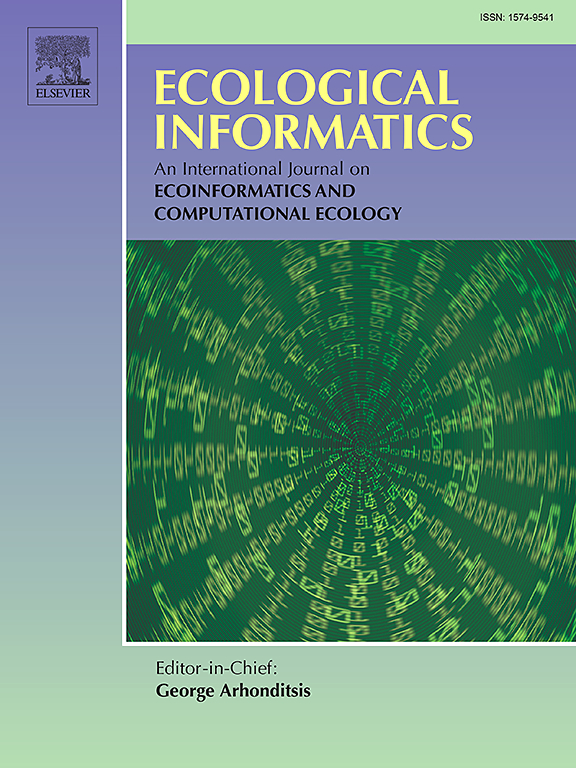利用深度学习方法对野生猛禽进行个体识别:以白尾鹰为例
IF 7.3
2区 环境科学与生态学
Q1 ECOLOGY
引用次数: 0
摘要
个体识别对于阐明动物种群结构、跟踪种群动态和揭示社会网络至关重要。计算技术的进步使得基于深度学习的方法能够应用于野生动物个体识别。然而,在复杂的野生环境中准确识别个体动物仍然是一个重大挑战。基于对野生动物个体准确、高效识别的需求,提出了一种基于深度学习的个体识别框架——目标跟踪-人脸提取-采样-识别(OFSR)方法。该框架利用深度学习提取面部特征,并利用跨任务信息共享的多任务模块整合补充数据,提高个体识别的准确性。利用OFSR框架对京新湿地越冬期白尾鹰个体进行了识别。我们的研究结果表明,OFSR框架可以准确地识别野生环境中的白尾鹰个体,准确率超过93%。此外,在OFSR框架的多任务模块中,使用年龄识别来提高个体识别的准确性,在不增加额外成本的情况下,成功地分离了重复个体和新个体,将准确率提高了2%。我们的研究结果证明了深度学习在复杂野生环境中识别单个动物的潜力,并且所提出的OFSR框架普遍适用于其他猛禽。研究结果强调,增加的多任务模块提高了识别单个动物的准确性。该框架可以提高复杂野生环境中个体识别的准确性,为涉及野生动物的种群检测和保护研究提供了一种有希望的方法。本文章由计算机程序翻译,如有差异,请以英文原文为准。
Individual identification of wild raptors using a deep learning approach: A case study of the white-tailed eagle
Individual identification is essential for elucidating animal population structures, tracking population dynamics, and uncovering social networks. Advances in computational technology have enabled the application of deep learning-based methods for individual wildlife identification. However, accurately identifying individual animals in complex wild environments remains a significant challenge. Motivated by the need for accurate and efficient identification of individual animals in the wild, a deep learning-based individual identification framework, the object tracking–face extraction–sampling–recognition (OFSR) approach, is proposed. This framework uses deep learning to extract facial features and a multitask module with cross-task information sharing to integrate supplementary data, enhancing individual identification accuracy. By employing the OFSR framework, we identified individual white-tailed eagles in the Jingxin Wetland during the overwinter period. Our results demonstrated that the OFSR framework could accurately identify individual white-tailed eagles in wild environments, achieving an accuracy exceeding 93 %. In addition, in the multitask module of the OFSR framework, age recognition is used to increase the individual identification accuracy, successfully separating recurring and new individuals and increasing the accuracy by 2 % without adding extra costs. Our results demonstrate the potential of deep learning in identifying individual animals in complex wild environments, and the proposed OFSR framework is universally applicable to other raptors. The findings highlight that the added multitask module increases the accuracy of identifying individual animals. Our framework could improve the accuracy of identifying individuals in complex wild environments, offering a promising method for population detection and conservation research involving wild animals.
求助全文
通过发布文献求助,成功后即可免费获取论文全文。
去求助
来源期刊

Ecological Informatics
环境科学-生态学
CiteScore
8.30
自引率
11.80%
发文量
346
审稿时长
46 days
期刊介绍:
The journal Ecological Informatics is devoted to the publication of high quality, peer-reviewed articles on all aspects of computational ecology, data science and biogeography. The scope of the journal takes into account the data-intensive nature of ecology, the growing capacity of information technology to access, harness and leverage complex data as well as the critical need for informing sustainable management in view of global environmental and climate change.
The nature of the journal is interdisciplinary at the crossover between ecology and informatics. It focuses on novel concepts and techniques for image- and genome-based monitoring and interpretation, sensor- and multimedia-based data acquisition, internet-based data archiving and sharing, data assimilation, modelling and prediction of ecological data.
 求助内容:
求助内容: 应助结果提醒方式:
应助结果提醒方式:


